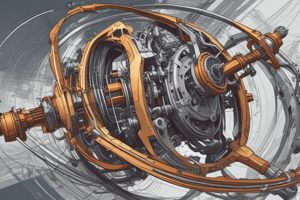Podcast
Questions and Answers
What condition must be met for a body to be in static equilibrium?
What condition must be met for a body to be in static equilibrium?
- The body must be fully supported by at least three points.
- The sum of forces and moments acting on the body must be zero. (correct)
- The body must be in motion at a constant speed.
- The sum of horizontal and vertical forces must equal the weight of the body.
Which law states that an object remains at rest unless acted upon by a net force?
Which law states that an object remains at rest unless acted upon by a net force?
- Newton’s First Law (correct)
- Law of Conservation of Momentum
- Newton’s Third Law
- Newton’s Second Law
What does a Free Body Diagram (FBD) represent?
What does a Free Body Diagram (FBD) represent?
- The internal stresses within a material.
- All forces acting on a body. (correct)
- The center of mass of a structure.
- The maximum load a structure can support.
How is the moment or torque (M) calculated?
How is the moment or torque (M) calculated?
What is the main purpose of a safety factor in structural design?
What is the main purpose of a safety factor in structural design?
What type of force acts at a distance rather than through direct contact?
What type of force acts at a distance rather than through direct contact?
In what type of structure are triangular units commonly found?
In what type of structure are triangular units commonly found?
What is the primary role of support reactions in structures?
What is the primary role of support reactions in structures?
Which of the following best describes non-contact forces?
Which of the following best describes non-contact forces?
Which principle states that acceleration is proportional to net force and inversely proportional to mass?
Which principle states that acceleration is proportional to net force and inversely proportional to mass?
Flashcards are hidden until you start studying
Study Notes
General Knowledge in Gk Statics
-
Definition of Statics:
- A branch of mechanics dealing with bodies at rest or moving at constant velocity.
- Focuses on forces and their effects on structures and systems.
-
Fundamental Concepts:
- Force: Vector quantity that causes an object to change its state of motion.
- Equilibrium: Condition where the sum of forces and moments acting on a body is zero.
- Types of Forces:
- Contact Forces: Forces that occur when objects are in direct contact (e.g., friction, tension).
- Non-Contact Forces: Forces that act at a distance (e.g., gravitational, electromagnetic).
-
Key Principles:
- Newton’s First Law: An object at rest remains at rest, and an object in motion continues in motion unless acted upon by a net force.
- Newton’s Second Law: The acceleration of an object is directly proportional to the net force acting on it and inversely proportional to its mass.
- Newton’s Third Law: For every action, there is an equal and opposite reaction.
-
Equations and Calculations:
- Static Equilibrium Conditions:
- (\Sigma F_x = 0) (Sum of horizontal forces)
- (\Sigma F_y = 0) (Sum of vertical forces)
- (\Sigma M = 0) (Sum of moments about any point)
- Moment (Torque): The rotational effect of a force, calculated as (M = F \times d), where (d) is the perpendicular distance from the pivot point.
- Static Equilibrium Conditions:
-
Applications of Statics:
- Structural Engineering: Analyzing buildings, bridges, and other structures to ensure stability.
- Mechanical Systems: Designing components that must stay in equilibrium under load.
- Aerospace: Assessing forces on aircraft when stationary.
-
Common Terms:
- Free Body Diagram (FBD): A graphical representation showing all forces acting on a body.
- Support Reactions: Forces exerted by supports on structures (e.g., fixed, roller, and pinned supports).
- Centroid: The geometric center of a shape, used to simplify calculations of areas and moments.
-
Types of Structures:
- Trusses: Frameworks made of triangular units to support loads.
- Beams: Structural elements that support loads perpendicular to their length.
- Frames: Combinations of beams and columns, often used in buildings.
-
Safety Factor: A design criterion that provides a margin for error, ensuring structures can support more load than they are expected to carry under normal conditions.
By understanding these key concepts and principles, one can effectively analyze static systems and structures within various fields of engineering and physics.
Overview of Statics
- Statics is a branch of mechanics focused on analyzing bodies at rest or moving at constant velocity.
- It examines the effects of forces on structures and systems.
Fundamental Concepts
- Force: Results in a change of motion; it is a vector quantity.
- Equilibrium: Achieved when the total forces and moments acting on a body equals zero.
Types of Forces
- Contact Forces: Arise from direct interaction between objects, such as friction and tension.
- Non-Contact Forces: Act at a distance; examples include gravitational and electromagnetic forces.
Key Principles
- Newton’s First Law: A body remains at rest or in uniform motion unless acted upon by a net force.
- Newton’s Second Law: The acceleration of an object is proportional to the net force and inversely proportional to mass.
- Newton’s Third Law: For every action, there is an equal and opposite reaction.
Equations and Calculations
- Static Equilibrium Conditions:
- (\Sigma F_x = 0): Sum of horizontal forces is zero.
- (\Sigma F_y = 0): Sum of vertical forces is zero.
- (\Sigma M = 0): Sum of moments about any point is zero.
- Moment (Torque): Calculated by (M = F \times d), with (d) as the perpendicular distance from the pivot point.
Applications of Statics
- Structural Engineering: Ensures stability in buildings, bridges, and other structures through analysis.
- Mechanical Systems: Involves designing components that must remain in equilibrium under various loads.
- Aerospace: Evaluates forces on stationary aircraft to ensure structural integrity.
Common Terms
- Free Body Diagram (FBD): A visual representation illustrating all forces acting on an object.
- Support Reactions: Forces provided by supports; includes fixed, roller, and pinned supports.
- Centroid: The geometric center of a shape, simplifying area and moment calculations.
Types of Structures
- Trusses: Composed of triangular units, providing stable load support.
- Beams: Structural elements designed to support loads perpendicular to their length.
- Frames: Combinations of beams and columns, commonly used in building construction.
Safety Factor
- A design principle that adds a safety margin, ensuring structures support more load than anticipated under normal operations.
Studying That Suits You
Use AI to generate personalized quizzes and flashcards to suit your learning preferences.





